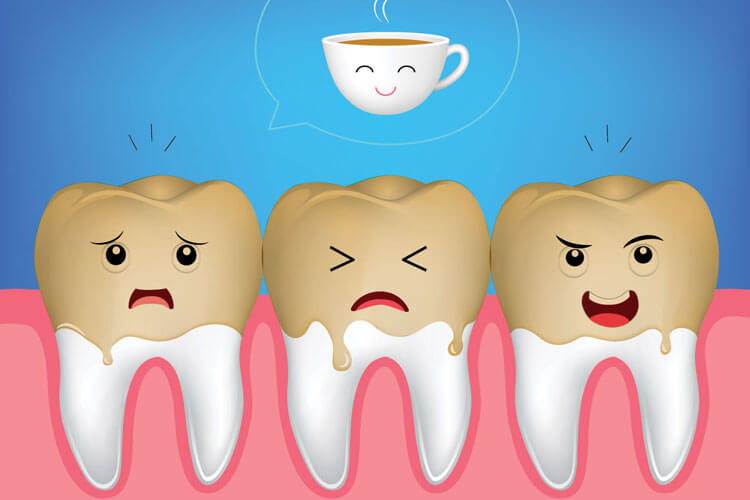Maintaining a healthy white smile requires more than regular brushing, flossing, and dental visits.
I t is important be mindful about what foods and drinks can stain our teeth. In general, foods and beverages with intense coloring can leave stains on teeth due to their chromogen content – a pigment-producing substance that can stick to tooth enamel, causing a stain. Acidic foods or drinks can erode your enamel, which increases a tooth’s surface area, thereby giving chromogen more chances to stick to teeth. Tannins are a food compound that helps chromogens stick to the enamel — there presence magnifies staining.
Here are some of the most prevalent foods and drinks which contribute to staining:

1. Wine
Wine drinkers know all too well what happens to their teeth by frequent consumption. Wine is notorious for unattractive staining and other disadvantageous effects on your teeth. The chromogens in wine contain intense colors and pigments. Tannins in red wine aid chromogens in binding to teeth, contributing to unsightly stains. White wine can also contribute to a yellow hue to teeth due to its low pH. Dr. Hawryluk explains high acidity can disintegrate enamel, exposing the yellow dentin. Wear and Tear of your teeth can act in concert with wine to create stains. Craze lines from wear facilitate the diffusion of chromogens and tannins from wine which pierce deep within the tooth, leaving stubborn stains. The representatives at our local “Wine Rack” in Port Credit, Mississauga; are knowledgeable in the differences between wines, including staining capability. You may want to consult with them when selecting a brand best for you.
You can shield your teeth from wine stains. Since wine is microscopically corrosive on teeth, cleaning teeth right after you drink it can cause destruction. It is best to wait one hour after wine consumption to brush your teeth. Pairing wine with cheese can also mitigate the acidity’s harm. Drinking through a straw might be a stretch for a wine connoisseur. However, if it doesn’t ruin the experience for you, this is a great way to reduce the wine’s contact with your teeth. It can be enjoyable to sip on wine slowly. We suggest though being aware that the longer the wine is in contact with teeth, the more corrosion can ensue. In other words, try and limited the contact time of the wine with your teeth as much as possible. If your teeth do get demineralized and stained from wine use, you can visit St. Lawrence Dentistry and we will get them back to looking great again.
Here’s our cleaning process which can get rid of stubborn stains.
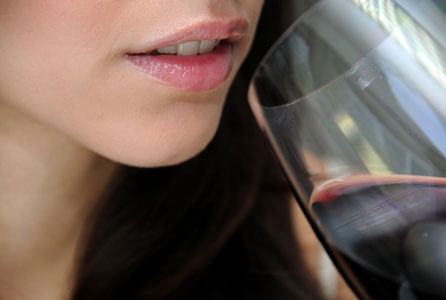
2. Curry
They may be tasty, but curry and tomato sauce cause teeth stains. Not only are curries and tomato sauce highly saturated, color-wise, but they’re also acidic. The brilliant yellow color is due to turmeric. Eating curry foods will give your teeth the same yellow color stain. Curry dishes combined with green leafy vegetables will help keep stains away by brushing your teeth and tongue immediately after eating. Because of turmeric’s health benefits in protecting against certain cancers, we should not avoid curry foods altogether. You can help stop curry from staining your teeth by eating lettuce along with balsamic vinegar. It can shield against staining from the curry ingredients. While enjoying a meal with staining capability, like curry, consider blending in fresh fruits and vegetables, including celery, cauliflower, peas, carrots, and apples. They’ll diminish stain development while you eat. Utilizing a slurry made of baking soda and hydrogen peroxide can aid in eliminating stains. Mix 1 teaspoon of baking soda with two teaspoons of hydrogen peroxide to make the slurry. Wash your mouth vigorously with water after brushing with this. If you live in Mississauga and would like to regain the original shade of your teeth give us a call.
Here is a link to the teeth whitening process:
Professional Teeth Whitening
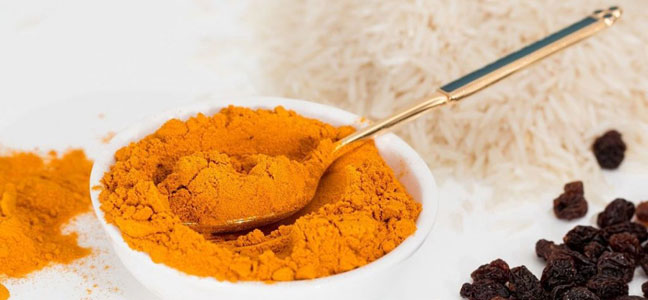
3. Coffee
Many drinks can alter your teeth’ shade over time. But one of the most infamous culprits is coffee because millions of Canadians consume it every sunrise and intermittently during the day to stay ‘perky’. Coffee’s discovery was in antiquity, around 1000 A.D. We have fully adopted this distinctly tasting hot drink into our daily routines. Coffee is legendary for its ability to give people a sense of alertness and euphoria. However, its prolonged use can sometimes have repercussions for your teeth. Coffee is very dark in color and can diffuse into the mini tooth tubules, where they can harden as the surface chills. When you permit the residue of your morning coffee to reside on your teeth for an extended period, it facilitates staining. Coffee is also has a low pH (high acidity)—substances that are high in acidity are more prone to weaken your teeth’ enamel. Stripping away of enamel exposes the teeth dentin layer, which is usually more yellow in appearance.
Excellent oral care is the key to preventing coffee staining. Suppose you’re one of the millions of people who love drinking the world’s favorite morning beverage. Brush regularly with a tooth whitening paste, and if the residue builds up, St. Lawrence Dentistry can polish it off. You can also minimize coffee’s effect on your front teeth by drinking it with a straw. Rinse your mouth after having a cup. You can fend off staining by mixing a small amount of milk into coffee, which whitens it and has the side benefit of being a calcium source. If you can’t get the coffee stains out yourself, St. Lawrence Dentistry has all the tools and ‘know-how’ to remove any stains impervious to your efforts. Give us a call to discuss.
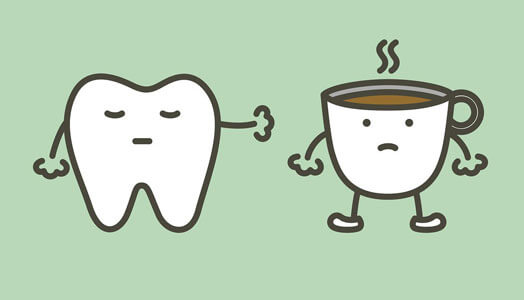
4. Blueberries
Blueberries are known for being rich in antioxidants, vitamins, and inflammation-fighting compounds. They’re also “nature’s candy” and delicious. The dark tint of the berries, blackberries, and raspberries are among the top teeth stain makers. If you’ve ever dropped a fresh, juicy berry on light clothing, you also know that they create a pretty stubborn stain. What’s true for your favorite cotton shirt is also true of your tooth enamel. If you eat blueberries too frequently, you can contribute to staining and darkening your teeth. They’re full of chromogens. Berrys are replete with color – blueberries, cranberries, raspberries, and blackberries can cause staining, whether they’re eaten whole, in juice form, or part of a jelly. Brushing after eating should be done. After eating a handful, make sure to swish your mouth with water to help remove the liquid from your teeth.
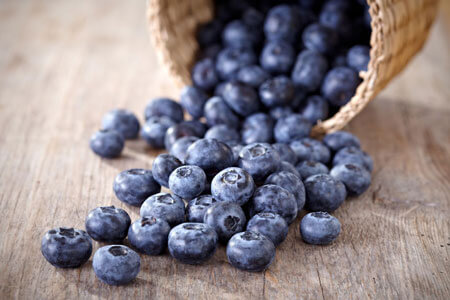
5. Energy and Sports Drinks
These drinks cause stains because they create pores in teeth in which stain-causing compounds can reside. The lower the pH, the higher the possibility of losing enamel from your teeth. Enamel is the hardest substance in people, even harder than bone. However, enamel dissolves in these highly acidic drinks. Even a tiny amount of a highly acidic drink can send your saliva’s pH plummeting. A single sip of energy drink can potentially send your saliva down to a pH of two. To regain its normal pH can take up to a half-hour. During that time, your mouth is in an acidic environment. Dr. Hawryluk sees the effects of energy beverages first hand. Energy drinks are almost as acidic as battery acid- which has a pH of one. Acidity facilitates bacterial growth which can lead to gum disease. Some people so are ‘wired’ after energy drinks that they grind their teeth. Tooth breakage and tooth loss correlate positively with grinding. Energy drinks can also spur more acid reflux production, which can, in turn, generates more cavities.
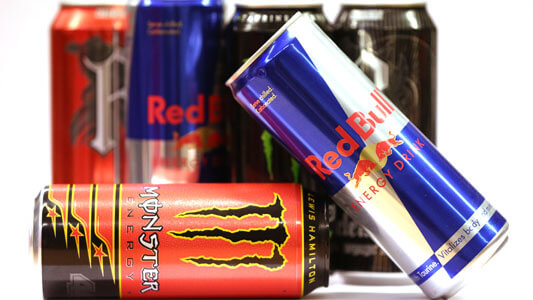
6. Dark Juices
Grape and cranberry juice are infamous generators of stains. While they are excellent sources of nutrients, they are replete with dark pigments and calories. Berries are rich in chromogen, and so are the juices derived from them. Like soda, their low acidity can dissolve tooth structure – leading to staining. Sticking to lighter colored juices can lessen staining. Specifically, as the light color may counteract and wash away stains left by other foods and drinks, Apple juice could help. Gentle swishing with water after drinking grape juice goes a long way in limiting grape stains.

7. Soy Sauce
Admirers of Asian cuisine might not be excited to learn that too much soy sauce could leave their teeth stained. Dr. Hawryluk Jr. goes so far as to call soy sauce “one of the worst offenders” for staining teeth because the dark coloring of soy can linger long after your meal is over. Generally, if food can stain your carpet or T-shirt, it can stain your teeth. If you do eat sushi or Chinese food, use the soy sauce sparingly. Soy sauce stains because it is replete with pigments. St. Lawrence Dentistry recommends using soy sauce sparingly. It is also high in sodium, which hurts blood pressure.
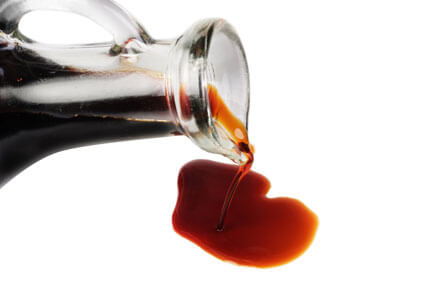
8. Tomato Sauce
Tomato sauce has worldwide popularity. Any tomato-based paste can stain your teeth. The tomatoes dark, rich color indicates high antioxidants and vitamins that your body needs. You don’t have to skip the sauce. It would help if you ate a salad beforehand. Greens like lettuce and broccoli will create a film on your teeth that will prevent staining from occurring. Be careful with sauces, like tomato-based ones, if you are in the middle of teeth whitening. When it comes to deciding what is safe to eat after teeth whitening, the general rule of thumb is whether it will stain a white shirt. Dark-colored sauces definitely will, so you’ll want to minimize eating them.
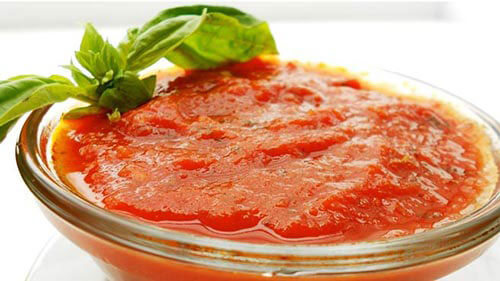
9. Balsamic Vinegar
Although healthier than ranch dressing salads, its dark pigments can stain your teeth. Since balsamic vinegar is high in acidity, it will innately adhere to teeth, allowing it to stain. Using a lighter vinegar instead is one way of minimizing stains. When having salads mixed with balsamic vinegar, be sure to include some lettuce. It may help your teeth clean and reduce the stain.
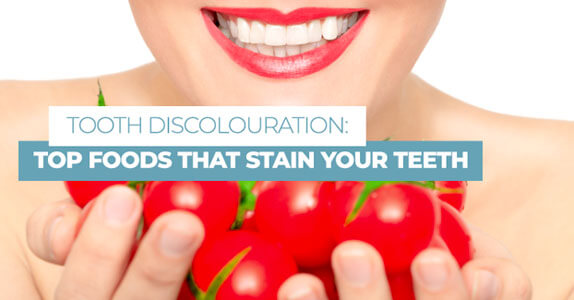
10. Beets
You may be aware that easily beets can stain just about anything. Not only will beat juice leave a “mean stain” on a shirt, but it will also stain your teeth. Beet juice is a potent staining agent, and it’s important to try and consume it in moderation if you don’t want your teeth looking like a set of rubies. Like blueberries and tomatoes, however, beets are good for you. They are full of nutrients that your body wants, but we should not ignore their staining power. Rinsing your mouth after eating may not be enough to prevent staining. Cleaning your teeth within an hour of eating is usually the best way to avoid stains.
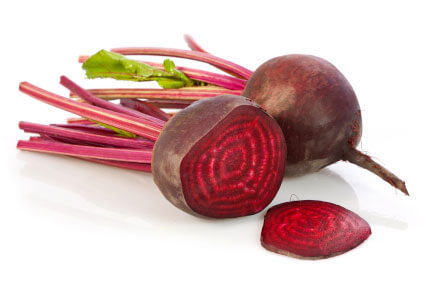
11. Tea
Some switch from coffee to tea in hopes that it will stain their teeth less. However, the problem is that tea is still full of tannins. Depending on the tea type, it will stain your teeth to varying degrees. The darker the tea is, the greater the likelihood it can stain your teeth. Dr. Hawryluk recommends green or white over darker black tea if you cannot get away from drinking tea. Putting milk into tea or drinking it by straw may help. Rinsing or drinking water after you finished with the tea can get rid of the dark pigments. Steeping tea for a little less time lightens it up a bit. Drinking tea can cause long-lasting discoloration. Fortunately, we can minimize staining by healthy oral hygiene. Brushing after you drink a cup of tea will reduce the amount of residue. For added stain-fighting, try brushing with Colgate Optic White, which can bleach teeth by several shades within a few weeks.
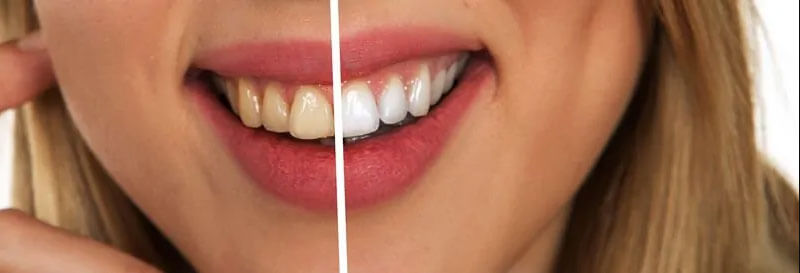
Many foods stain teeth, but a “great good deal” of them have fantastic health benefits as well. Dr.Hawryluk Jr. recommends responsible consumption involving reasonable portions and a good oral care routine. If stains develop, we welcome you to our Mississauga Dental Office to get rid of them. We hope you have enjoyed the article and thank you for reading it!
- St. Lawrence Dentistry Looks Forward To St. Patrick’s Day! - March 12, 2025
- Understanding Dental X-Rays and Radiation: What You Should Know - January 13, 2025
- Happy New Year from St. Lawrence Dentistry! - December 30, 2024



